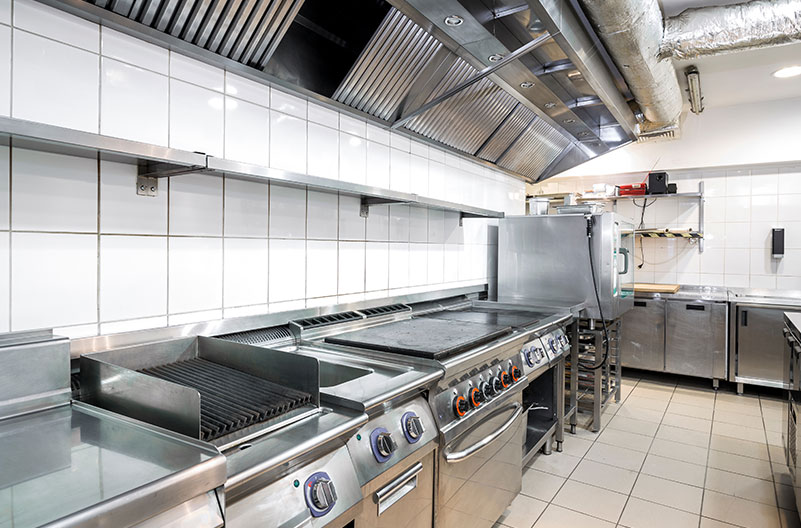Effective Cleaning in a commercial kitchen


As anyone in a food industry role knows, cleaning is the most powerful tool in the fight against cross contamination. Cleaning is not just about keeping up appearances – efficient and effective cleaning in a commercial kitchen eliminates breeding spaces for harmful bacteria. In its absence, pathogens multiply to dangerous levels, can spread widely within their environment and create a very real risk of food poisoning.
As they are the cornerstone to kitchen hygiene, it is worthwhile taking the time to recap the principles of good cleaning practice.
When cleaning work surfaces and equipment, two cleaning chemicals are required. Detergents (or degreasers) are used first to remove waste and grease. Disinfectant is then employed to kill pathogens. Some cleaning products combine both detergents AND disinfectant – but in all cases, the manufacturer’s instructions must be followed. These include ‘contact time’ – the time the product must be left on the surface before wiping – and dilution. This is important not only to ensure efficacy of the product, but also to provide some residual protection against bacteria after the product has been used.
In the UK, cleaning products meeting the BS EN standards (BS EN 1276 or BS EN 13697) are suitable for use in commercial kitchens.
Cleaning schedules are a crucial part of any food business’ HACCP plan, and, if created using a comprehensive risk assessment approach, form a suitable framework to ensure both front of house and food service personnel perform required cleaning tasks regularly. Cleaning schedules often form a visible indicator of hygiene standards to customers, when displayed in public areas that need very regular cleaning, such as bathrooms.
Some larger companies are now turning to tech solutions for completing cleaning schedules, alongside other HACCP paperwork. Online FSMS solutions are currently early in their development, but no doubt will develop over the next few years to provide a streamlined alternative to paper-based records.
So where are our cleaning ‘blind spots’? According to our consultant EHO, a number of areas are often overlooked when it comes to cleaning, including:
Manual Tin Openers – often used and then thrown straight back in a drawer, tin openers can harbour moisture and protein, and make and ideal breeding ground for bacteria.
Wire Safety guards on food mixers – whilst bowls and whisks are removed and cleaned, the equipment itself is often neglected, and food residue left behind.
Vacuum pack machines and wet bains-marie – the liquid left in the bottom of these machines is sometimes left at the end of service; the warm, contaminated water forms an effective bacteria soup.
Handwash basins – these are often neglected. By nature of their use, handbasins present a high risk of cross contamination, and should be treated as a common touch point for cleaning purposes.
Deep cleans – this is one of the jobs that is often neglected. Cleaning underneath cupboards, behind equipment and inside cupboards should take place weekly in a busy commercial kitchen.
One positive outcome from the pandemic period has been an increased awareness of the importance of good cleaning practices, both front of house and in the kitchen. Whilst levels of cleaning activity have generally reduced since the height of the pandemic, businesses with a good safety culture, managers who lead by example and participate in comprehensive food safety training programmes are typically demonstrating better cleaning practice than in pre-pandemic times.
Good hand hygiene unsurprisingly increased in both staff and customers during the peak pandemic period. According to reports by the FSA (Consumer Handwasher Tracker, The Food Standards Agency, August 2022), handwashing has slipped somewhat from the public’s priorities, but still remains higher than reported pre-pandemic behaviour.
The early stages of the covid-19 pandemic saw a period of uncertainty, where information about preventing the spread of the covid virus was scarce and often conflicting. This period saw a rise in use of chlorine-based products, including bleach, as disinfectants – partly due to misinformation, but also in response to supply issues. Unfortunately, this practice has remained in some commercial and domestic kitchens. Bleach (and other chlorine based products) are corrosive, potentially harmful to health and dangerous when used in combination with other chemicals – and as such should not be used as a disinfectant in food production environments.
Environmental concerns have led to an increase in development of ‘eco’ cleaning products, and a wide range of these products are now available for domestic use. For commercial kitchens, there are now a small number of environmentally responsible cleaning products available from wholesalers, including the ChemEco range, that meet the necessary BS EN standards.
As with any chemical product, cleaning products should never be mixed with other chemicals, should remain in original packaging where possible, and if diluted and decanted, users must have access to the manufacturer’s instructions.
Surprisingly, the pandemic has not left a raft of new, improved cleaning tech in its wake. However, one key move in the market – the restriction of single use plastics in force since October 2023 – may have a positive influence. Retailers are being encouraged to accept customers’ containers for take-away foods; however, this presents an obvious cross contamination risk. Could we see a development in UV technology that provides a quick, effective method of sanitising take-away tubs for reuse?
This information post has been compiled by The Safer Food Group, leading training provider to the food industry. For more information about our courses, please visit www.thesaferfoodgroup.com or email info@thesaferfoodgroup.com
Join 950,000+ learners
Explore our award winning online video based training
The Safer Food Group
Unit 2, Integrity House,
Lower Lumsdale, Matlock
DE4 5EX
Back
to top
© The Safer Food Group 2025 | Privacy policy